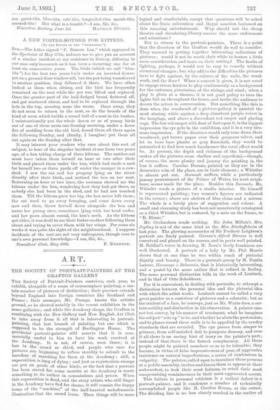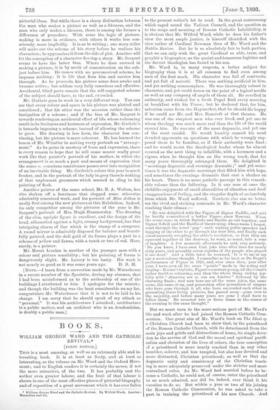ART.
THE SOCIETY OF PORTRAIT-PAINTERS AT THE GRAFTON GALLERY THE Society of Portrait-Painters contrives, each year, to exhibit, alongside of a mass of commonplace painting, a cer- tain number of pictures of distinction ; their purview extends beyond England into foreign countries like Scotland and France ; their manager, Mr. Prange, knows the artistic ground, as he showed notably in the recent exhibition in the same galleries ; and while the Academy sleeps, the Grafton is combining with the New Gallery and New English Art Club to take away from it all that is interesting in portrait. Painting, that last branch of painting but one which is supposed to be the strength of Burlington House. The Provincial portrait-painter still asserts that it is com- mercially useful to him to have his work received at the Academy. It is not, of course, seen there ; it is lost in the crowd or skied, and people who care for pictures are beginning to refuse sturdily to submit to the boredom of searching for them at the Academy ; still, a superstition is long of dying ; and just as registration-stamps are put on goods of other kinds, so the fact that a portrait has been stored for some months at the Academy is worth something to its author in commissions and prices. When this superstition is dead, and the stray artists who still linger in the Academy have fled for shame, it will remain the happy home of the "machine," of the half-hearted melodramatic illustration that the crowd loves. Then things will be more logical and comfortable, except that questions will be asked about the State subvention and Royal sanction bestowed on this amazing entertainment. Why should not the cheap theatre and circulating-library receive the same endowment and attentions P But to return to the portrait-painters. There is a point that the directors of the Grafton would do well to consider. They succeed in getting together interesting collections of pictures ; would it not be worth their while to bestow a little more consideration and taste on their setting P The faults of lighting, perhaps, it would not be easy to remedy without structural changes ; but why add to the difficulties the pictures have to fight against, by the colours of the walls, the wood- work, and the floor P When a concert is given, it is not usual to engage steam-hooters to play continuously as a background for the entrance, pianissimo, of the strings and wind ; when a play is given at a theatre, it is not good policy to turn the lights full on throughout the house, and invite the audience to drown the actors in conversation. But something like this is done when the woodwork of a picture-gallery is painted the most staring white against a deep absorbent purple velvet in the hangings, and above a discordant red carpet and glaring rugs. The hot red carpet with dust of feet upon it, is the biggest impression the eye gets in the exhibition, and it is a very tire- some impression. If the directors would only tone down their woodwork, put brown paper over their gorgeous velvet, and let us have bare planks or grey floorcloth, they would be astonished to find how much handsomer the total effect would be. At present, the depth and richness of the background makes all the pictures seem shallow and superficial,—though, of course, the more plushy and jammy the painting is, the less it suffers. Carolus Durans, painted as they are in the decorative vein of the place, are in their element ; a Whistler is almost put out. Sarasate suffers, while a particularly jimmy presentment of the Prince of Wales, his next neigh- bour, seems made for the place. Besides this Sarasate, Whistler sends a picture of a studio interior. He himself is represented painting ; two women's figures are indicated in the corner; above are shelves of blue china and a mirror. The whole is a lovely piece of suggestion and colour, A small and charming study has been not unnaturally catalogued as a third Whistler, but is restored, by a note on the frame, to "R. Birnie."
Mr i Orchardson sends nothing, Sir John Millaie's Mrs. .Topling is not of the same kind as the Mrs. Bischoffsheim of last year. The glowing accessories of Sir Frederic Leighton's portrait are finely painted. Gervex's .Alfred Stevens is well conceived and placed on the canvas, and in parts well painted. M. Boldini's verve in drawing, M. Zorn's lively frankness are well illustrated. A portrait of a lady by Mr. Phil Morris shows that at one time he was within reach of pictorial dignity and beauty. There is a portrait-group by M. Fantin Latour, Hommage d Delacroix, that is historically interesting, and a pastel by the same author that is refined in feeling. The same personal distinction tells in the work of Lenbach, and in that of Otto Scholderer.
For it is convenient, in dealing with portraits, to attempt a distinction between the personal idea and the pictorial idea, with whieh the artist works. Lenbach cannot be called a very great painter as a contriver of pictures and a colourist; but as the student of a face, he conveys, just as Mr. Watts does, a cer- tain nobility and distinction in his observation. A painter can- not but convey, by his manner of treatment, what he imagines his subject " sets up" to be, and whether he abets the pretension; and to glance round these walls is to be appalled by the tawdry standards that are revealed. The eye passes from simper to grimace, from self-satisfied doll to pompous dummy, and over it all there is no saving hint of irony on the painter's part instead of that there is the fattest complacency. All these people might be painted somehow so as to be tolerable; they become, in virtue of false impressiveness of pose, of aggressive insistence on natural imperfections, a series of •confessions in vulgarity. The painter, called upon to introduce those persons at a public assembly, invites and forces them 'co appear at their awkwardest, to look their most fatuous, to retail their most compromising reminiscences in their most aggravated accent.
This failure in personal criticism is a radical defect in a portrait-painter, and it condemns a number of technically accomplished people like M. Carolus Duran, at the outset. The dividing line is no leas clearly marked in the matter a pictorial ideas. But while there is a sharp distinction between the man who makes a picture as well as a likeness, and the man who only makes a likeness, there is among the former a difference of procedure. With some the logic of picture- making is more in evidence, with others it works less con- sciously, more implicitly. It is as in writing ; one story-teller will make out the scheme of his story before he realises his characters ; he approaches it from the Bide of plot. Another will let the conception of a character develop a story. Mr. Sargent seems to have the latter bias, Where he does succeed in making a picture, it is by merit of concentration on the sub- ject before him. He comes with no preconceived scheme, he imposes nothing ; it is life that fires him and carries him through. As he proceeds, his picture sense does awake and become active ; but seldom very fully conscious and effective. Accidental, blind parts remain that the self-suggested scheme of the subject should have, in the end, extruded.
Mr. Gathrie goes to work in a very different way. You can see that every colour and space in his picture was plotted and ,considered ; that his sitter was the occasion rather than the instigation of a scheme ; and if the bias of Mr. Sargent is towards rendering an accidental effect of life whose redeeming merit is its liveliness and keenness of expression, Mr. Guthrie's is towards imposing a scheme, instead of allowing the scheme to grow. His drawing is less keen, the character less con- vincing, but the picture is more coherent. He has learned the lesson of Mr. Whistler in making every portrait an "arrange- ment." As he gains in mastery of form and expression, there is every reason to hope that he will come nearer really great work like that painter's portrait of his mother, in which the arrangement is so much a part and means of expression that the sense oi conscious contrivance passes over into recognition of an inevitable thing. Mr. Guthrie's colour this year is much fresher, and in the portrait of the lady in grey there is nothing of that unpleasant greenness which seemed to cling to his painting of flesh.
Another painter of the same school, Mr. E. A. Walton, has also shaken off a heaviness that clogged some otherwise admirably conceived work, and his portrait of Miss Aitken is easily first among the new pictures at this Exhibition. Indeed, its only competitor among the pictures of the year is Mr. Sargent's portrait of Mrs. Hugh Hammersley. The drawing of the slim, upright figure is excellent, and the design of the head, silhouetted against a light, creamy background, has that intriguing charm of line which is the stamp of a composer. A round mirror is admirably disposed for balance and beauti- fully painted, and the dull gold of its frame plays a part in a scheme of yellow and fawns, with a touch or two of red. Here, surely, is a painter.
Mr, Mouat Louden is another of the younger men with a colour and picture sensibility ; but his painting of forms is dangerously slight. Mr. Lavery is too hasty. His work is
not nearly so good as it was some years ago. D. S. M.
[NoTE.—I learn from a correction made by Mr. Waterhouse in a recent number of the Spectator, during my absence, that I had been misinformed as to the authorship of one of the buildings I attributed to him. I apologise for the mistake, and though the building was the least considerable on my list, congratulate Mr. Waterhouse that it is not to be laid to his -charge. I am sorry that he should speak of my attack as "personal." It was his architecture I attacked; architecture is a public matter, and an architect who is an Academician, is doubly a public man.]







































 Previous page
Previous page